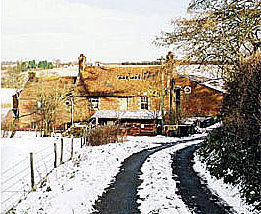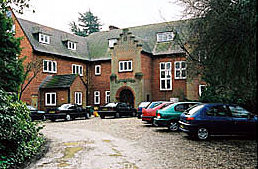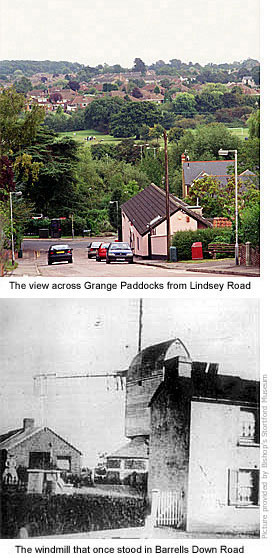|
|
|
 |
|
|
|
|
|
|
|
Foxdells Lane
|
|
 In the late 19th century, the entire area between this point and Maze Green Road (approx 250 acres) was owned by the Gilbey family and known as Whitehall Estate. At that time it included Dane O’ Coys Farm (See Guide 5) and Foxdells Farm, and though neither now exist as actual farms the latter was reached by this lane – little more than a cart track and one of the few gravel roads left in Bishop’s Stortford. In the late 19th century, the entire area between this point and Maze Green Road (approx 250 acres) was owned by the Gilbey family and known as Whitehall Estate. At that time it included Dane O’ Coys Farm (See Guide 5) and Foxdells Farm, and though neither now exist as actual farms the latter was reached by this lane – little more than a cart track and one of the few gravel roads left in Bishop’s Stortford.
At its start is the entrance to Rye Court – part of Sir John Barker’s former home – and a small terrace of cottages built in the 1800s to house estate workers and their families. At the top of the hill a gate gives entrance to Foxdells Farm, now a ramshackle of listed buildings in poor condition but used, since the early 1990s, as an animal rescue centre.
A good example of a property developer’s ingenuity stands at the corner of Foxdells Lane and Whitehall Lane. An old feed store and cattle shed, once owned by Foxdells farm, has now been cleverly converted into two homes. Each carries a nameplate as a reminder of past landowners here – Gilbey and Barker.
Whitehall Lane runs alongside the old perimeter wall of The Grange, the scale of its former grounds not fully realised until you reach the end of the wall where the lane joins Barrells Down Road. Just before that point is reached, a track to the right leads through a wooded area to Dane O’ Coys and the site of the former property called Whitehall, which in more recent years became Whitehall College. MORE PICTURES
|
|
|
|
Whitehall
|
|
 The original Whitehall, a twelve-bedroomed property standing in 37 acres of land, was built by Sir John Barker for his only daughter Ann and her husband Tresham Gilbey, the third son of Sir Walter Gilbey. The couple, who married in 1886 spent the first nineteen years of their married life living with Ann's parents at The Grange, not moving out until 1905, two years after her mother Sarah's death. Their new home, Dane House standing opposite the entrance to Silver Leys in Hadham Road, was also built for them by her father Sir John. The original Whitehall, a twelve-bedroomed property standing in 37 acres of land, was built by Sir John Barker for his only daughter Ann and her husband Tresham Gilbey, the third son of Sir Walter Gilbey. The couple, who married in 1886 spent the first nineteen years of their married life living with Ann's parents at The Grange, not moving out until 1905, two years after her mother Sarah's death. Their new home, Dane House standing opposite the entrance to Silver Leys in Hadham Road, was also built for them by her father Sir John.
The story goes that Sir John's daughter didn't much like Dane House after she and her husband took up residence, so moved back in with her father at The Grange where they stayed for a further ten years. When Sir John died in 1914 he is said to have left no heir, which implies his daughter was not included in his will. True or not, prior to his death Sir John is thought to have instigated the building of Whitehall for the couple, into which they moved in in 1916 and remained for the rest of their married life. It was here also, in 1933, that they entertained the Duchess of York (the late Queen Elizabeth the Queen Mother) before she officially opened a new wing of Rye Street Hospital.
*Dane House does still stand, but since 1905 has seen several changes to its use and structure (See Guide 7 – Dane House).
Ann Tresham Gilbey died in 1941, Tresham Gilbey in 1947, aged 84. The house and estate was then put up for auction sale but on failing to reach its reserve price, Whitehall was withdrawn and the rest of the estate split up and sold in separate lots.
Horses played a large part in Tresham Gilbey's life and consequently Whitehall included large stable blocks. Soon after his death this part of the estate was taken over by a former cavalry officer, Percy J Rhimes, for use as a riding school of which he was the chief instructor. From the early 1950s the house itself became the Senior Boarding House for girls attending nearby Chantry Mount High school (See Guide 5), and Whitehall Riding School continued throughout the 1950s and into the 1960s.
When Chantry Mount High School closed in the 1970s so too did Whitehall, remaining empty for several years and becoming almost derelict. Its salvation came in the early 1980s when it was bought, along with 37 acres of land, by The Manufacturing Science and Finance Union (MSF) for use as their head office and as a training college. They restored the house to its former glory, adding extensions to accommodate 55 students and providing many facilities, including a swimming pool and sauna. In 1987 the college was the venue of an historic Labour Party decision on its constitution, under the leadership of Neil Kinnock.
In 2001 the MSF merged with the Amalgamated Engineering and Electrical Union to form Amicus, and in 2007 Amicus merged with the TGWU to form Unite. That same year a survey of the properties that made up Whitehall College, is said to have revealed the presence of large amounts of asbestos, which would prove far too expensive to remove. As a result of this Unite sold the property and vacated it in 2007.
Local property developers Arlberg Group moved in in late 2008, demolishing most buildings to do with the former college including the old stable blocks, dormitories and theatre. Currently (2010) the large site is being redeveloped for exclusive housing – ten in total, two of which will cost in excess of £1.5m. Whitehall itself is to be refurbished and converted to a 5-bedroom luxury home.
Read Joy Gurden's childhood memories of her time spent at Whitehall Riding School in the 1950s: SEE MEMORIES PAGE, GUIDE 7
MORE PICTURES
|
|
|
|
Barrells Down Road (Windmill) and Lindsey Road
|
|
 The undulating character of Bishop’s Stortford is barely noticeable as we transport ourselves everywhere by car, but its hilly terrain is certainly apparent when walking. The undulating character of Bishop’s Stortford is barely noticeable as we transport ourselves everywhere by car, but its hilly terrain is certainly apparent when walking.
The potential of these hills was fully realised in the 17th and 18th centuries when the demand for flour by a growing population, both locally and nationally, far exceeded the output of water mills. The answer to the problem was windmills, and Bishop’s Stortford is known to have had three. One was was sited on this hill in Barrells Down Road opposite Whitehall Road, and in one early illustration of the town it can be clearly seen in the distance.
The first recorded owner of the windmill was a miller named Thomas Davey, who lived here with his wife in 1841. It was then taken over by Thomas Linsell, the 1851 census recording him as ‘Miller and Baker of Lindsey Common’. However, a later census lists him as just a Baker and it isn’t known if the windmill was still used to produce flour at that time.
By 1890 the Bakery – housed in a two-storey building – was in the hands of Edward Button, who continued to run it as such until at least the turn of the 20th century. When the windmill was finally taken down is unknown but on part of the site was a long stable/cart shed, which, though much altered, now forms part of the premises of 150 Barrells Down Road.
A Government priority after the First World War was reconstruction, not only of social services such as education, health care and transport, but also housing – the estimate being that 800,000 new council houses were needed to replace unsafe inner city slums. With the passing of the Addison Act building work began, but was abandoned in 1922 after little more than 200,000 houses were built. Good housing proved far too expensive for a government already deeply in debt because of the war. This led to the Housing Act 1922–1930, which encouraged house building by granting subsidies to private developers. A further act in 1924 subsidised local authorities to do the same. The result was what we now call 'Suburbia'.
Bishop's Stortford certainly wasn't blighted by slum housing, but even here the housing act paved the way for new property developments and town expansion. Locally, *Lindsey Road was one of the first areas to feature new properties borne of the Act: semi-detached 3-bedroom houses built in the now familiar 30s style and stretching almost the entire length of the northern side of the road. These were followed in 1936 by the nearby development of Pinelands estate (situated behind Lindsey Road) and also of Meadowlands and Grangeside in Rye Street.
Present day house buyers faced with ever increasing prices may wince at this, but in 1936 a new 3-bedroom semi-detached freehold property in Pinelands was advertised at £535. For this you also got a tiled bathroom with porcelain bath suite and toilet, airing cupboard, electric fires, living room with bay window, separate dining room and garden. A deposit of £5 secured any site. Those unable to afford the cash price of a house could put down a £30 deposit and pay a mortgage of 14s. 5d. (72p) per week. One advertisement of the time described the properties thus: Houses of no regrets; small houses of character, houses of honest-to-goodness value, where every brick is well and truly laid.
By the late 1930s over 300,000 similar style houses were being built every year, and between the end of World War I and the beginning of World War II over four million houses had been constructed.
*Lindsey Road was formerly a cart track linking Rye Street with Barrells Down Road. It takes its title from the original name of this area, Lindsey's Field. MORE PICTURES
|
|
|
|
[ BACK TO TOP ] |
|
|
|
|
|
|
|
|
|

